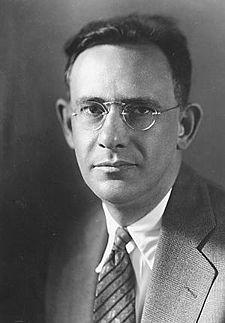Edward Sapir facts for kids
Quick facts for kids
Edward Sapir
|
|
|---|---|

Edward Sapir (c. 1910)
|
|
| Born | January 26, 1884 |
| Died | February 4, 1939 (aged 55) New Haven, Connecticut, U.S.
|
| Citizenship | United States |
| Alma mater | Columbia University (AB, AM, PhD) |
| Known for | Classification of Native American languages Linguistic relativity Anthropological linguistics |
| Scientific career | |
| Institutions | University of Chicago Canadian Museum of Civilization Columbia University Yale University |
| Thesis | The Takelma Language of Southwestern Oregon (1909) |
| Doctoral advisor | Franz Boas |
| Doctoral students | Li Fang-Kuei Mary Haas Morris Swadesh Kenneth Pike Harry Hoijer Leslie A. White Robert Redfield Stanley Newman J. David Sapir Charles Hockett John Dollard |
Edward Sapir (January 26, 1884 – February 4, 1939) was an American anthropologist and linguist. He is known as one of the most important people in the study of languages in the United States.
Sapir was born in what is now Poland. His family moved to the United States when he was a child. He studied languages at Columbia University, where he met Franz Boas. Boas inspired him to study Native American languages. Sapir worked for the Geological Survey of Canada for fifteen years. Later, he became a professor at the University of Chicago and then at Yale University.
Sapir explored how language and culture affect each other. He was interested in how different languages lead to different ways of seeing the world. His student Benjamin Lee Whorf later developed this idea into the "Sapir–Whorf hypothesis." Sapir also believed that understanding individual personalities was important for studying how cultures grow.
One of his biggest contributions was classifying Native American languages. He also helped develop the modern idea of the phoneme, which is a basic sound unit in a language. Sapir showed that the methods used to study European languages could also be used for Indigenous languages.
Contents
Who was Edward Sapir?
Edward Sapir was born in Lauenburg, German Empire (now Lębork, Poland). His family was Lithuanian Jewish. His father was a cantor, a singer in a synagogue. Edward's first language was Yiddish.
In 1888, when he was four, his family moved to Liverpool, England. Then, in 1890, they moved to Richmond, Virginia, in the United States. The family later settled in New York City. Edward's mother, Eva Seagal Sapir, worked hard to support the family. She taught Edward the importance of education.
At age 14, Edward won a scholarship. He chose to attend DeWitt Clinton High School instead of a more expensive school. This allowed him to save his scholarship money for college.
What did Sapir study at Columbia University?
Sapir started at Columbia University in 1901. He studied many languages, including Latin, Greek, and French. He also focused on Germanic languages like Gothic and Old High German.

In his last year, he took a class called "Introduction to Anthropology." This class was taught by Professor Livingston Farrand. Sapir also took a special seminar with Franz Boas, a very important anthropologist. This class changed Sapir's career path.
Boas introduced Sapir to Native American languages. Sapir's master's thesis looked at how languages change over time. He argued that all languages, no matter where they come from, have equal beauty and complexity. He believed it was important to study all kinds of languages to understand how language works.
After finishing his classes, Sapir began his doctoral research. He spent several years doing fieldwork.
Where did Sapir do his early fieldwork?
Sapir's first fieldwork was in 1905. He studied the Wishram Chinook language. His work helped him understand the sounds of this language better than others had before.
In 1906, he worked on the Takelma language. This work became his doctoral dissertation. He paid close attention to how native speakers heard and used sounds. This helped him develop his ideas about the phoneme.
From 1907 to 1908, Sapir worked at the University of California, Berkeley. He studied the nearly extinct Yana language. He worked with Betty Brown and Sam Batwi, two of the last speakers. Sapir noticed how the Yana language used different words and grammar for men and women.
In 1909, Sapir went to Utah to study the Southern Paiute language. He worked with Tony Tillohash, who was a great helper. Tillohash's understanding of his language's sounds helped Sapir show that the phoneme is a real thing for speakers. This work led to a famous description of the Southern Paiute language. It also helped Sapir prove that the Uto-Aztecan languages were a single language family.
What did Sapir do in Canada?
From 1910 to 1925, Sapir led the Anthropological Division of the Geological Survey of Canada in Ottawa. He was one of the first full-time anthropologists in Canada. He started a project to document the Indigenous cultures and languages of Canada.
Sapir believed that studying languages was very important for understanding cultures. He argued that you couldn't truly understand a culture's stories or traditions without knowing its language. He worked on languages like Nootka and Athabaskan languages.
Sapir also supported Indigenous rights in Canada. He spoke out for better healthcare for Indigenous communities. He helped the Six Nation Iroquois try to get back stolen wampum belts. He also argued against a law that banned the Potlatch ceremony of West Coast tribes.
In 1915, Sapir returned to California to work with Ishi. Ishi was the last speaker of the Yahi language, which was related to Yana. Ishi had grown up without contact with white people. Sapir had to invent new ways to work with someone who spoke only Yahi. This work was very important for understanding the different Yana dialects.
During his time in Canada, Sapir wrote important books. One was Language: An Introduction to the Study of Speech (1921). This book explained linguistics to a general audience. He also wrote poetry and collected French Canadian folk songs.
What did Sapir do in Chicago and Yale?
In 1925, Sapir moved to Chicago to become a professor at the University of Chicago. This move brought new energy to his work and personal life. He met with other thinkers and joined poetry and music clubs. His first graduate student there was Li Fang-Kuei.
In 1926, Sapir remarried. His second wife was Jean Victoria McClenaghan. They had two sons, Paul Edward Sapir and J. David Sapir. J. David Sapir later became a linguist and anthropologist, like his father.
From 1931 until his death in 1939, Sapir taught at Yale University. He became the head of the Anthropology Department. He wanted to create a program that combined anthropology, linguistics, and psychology. This program would study how culture affects personality.
At Yale, Sapir taught many students who became famous linguists, including Morris Swadesh, Benjamin Lee Whorf, and Mary Haas.
Sapir had heart problems in his later years. He died in 1939. After his death, his efforts to combine anthropology, psychology, and linguistics at Yale were mostly stopped.
How did Sapir think about culture?
Sapir had unique ideas about anthropology. He was interested in how individual personalities shaped cultural patterns. He believed that studying how different people relate to each other was important for understanding how cultures develop.
Sapir thought that individual creativity and cultural traditions worked together to create new forms of art and expression. He saw this same idea in how individuals and cultures influenced each other.
What languages did Sapir study?
Sapir was especially interested in the Athabaskan languages. He once wrote that it was "most fascinating of all languages ever invented." He also studied languages like Wishram Chinook, Navajo, Nootka, Colorado River Numic, Takelma, and Yana. His work on Southern Paiute helped define the idea of the phoneme.
Even though he was known for his work on American languages, Sapir wrote a lot about linguistics in general. His book Language discussed how languages are classified. It also explored how languages change over time and how language, race, and culture are connected.
Sapir was also a pioneer in studying Yiddish, which was his first language. He also supported the idea of an international auxiliary language, a language designed to help people from different countries communicate. He believed such a language should have clear rules and not be tied to any single national language.
Images for kids
-
Franz Boas, Sapir's mentor at Columbia University
See also
 In Spanish: Edward Sapir para niños
In Spanish: Edward Sapir para niños


